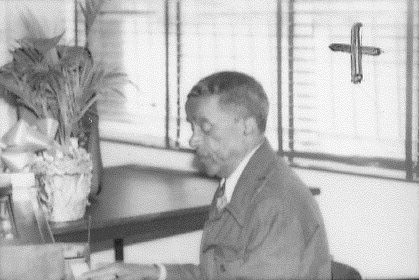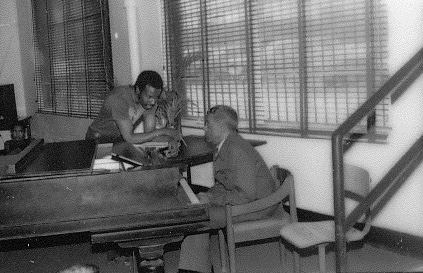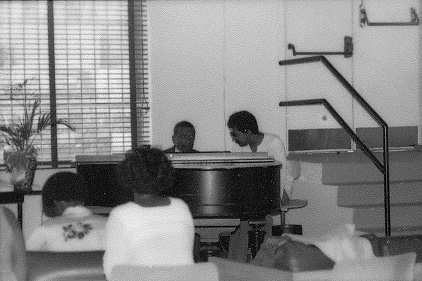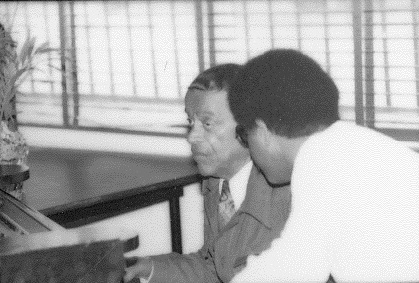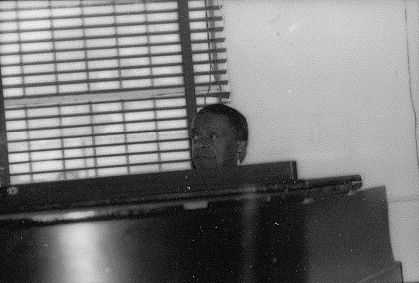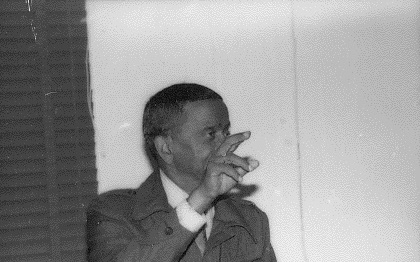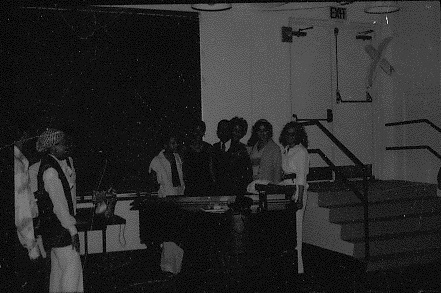Claude Hopkins was born August 24th, 1903 in Alexandria, Virginia. His parents, Albert and Gertrude Hopkins both worked at a school for orphans in Blue Plains. When Claude was a young boy, the family moved to Washington DC after both parents received opportunities to work at Howard University.
Read Full Bio
His father, a postmaster, and mother a matron at Howard wanted Claude to go to medical school. Claude enrolled at Howard University as a medical student, but soon became intrigued with classical piano and theory, graduating with a BA in Music.
Soon after graduation, he embarked on a journey to begin a career as a jazz pianist. He began performing in local clubs around Washington and ended up at Dreamland cafe on 7th street, with Jimmy McGriff on drums and Eddie White on violin, in the early 1920s. The trio when on to play at Washington club, Oriental Gardens, up till 1924, when Hopkins was offered a chance to perform at a club in Atlantic City in 1925. Hopkins moved on to Atlantic City with a new band made up of Henry Goodwin on trumpet, Daniel Doy on trombone, Joe Hayman on saxophone, and Tommy Miles on drums. They signed a contract with the owner of the club Herndon Daniels, a shady guy whose club was soon rated by Prohibition officers, leaving Hopkins and his band members jobless. They left Atlantic City in the summer of 1925 with little money and hopes of a new opportunity. Stumbling upon Smile Awhile Cafe in Asbury Park, New Jersey, Hopkins walked in to grab a bite after a long trip and luckily walked in on an audition process. One of the partners of the club, Dr. Aarol Mosel, decided to give the band a contract on the spot. Unknowingly, Hopkins had replaced Bill Basie’s big band for the position. The Smile Awhile Cafe was one of Hopkin’s big breaks. With a booming summer of performances, rumors began to circulate of a Mrs. Caroline Dudley Reagan, who was looking for a big band to join her in Europe. She auditioned Hopkins for a musical director position and he and the band were invited to join the Revue Negre in Paris.
The band practiced in NYC for several weeks and was renamed “The Claude Hopkins Orchestra” and Sidney Bechet joined the band as a clarinetist. Josephine Baker was signed to be the star of the show, beginning her long, successful career as a dancer and singer. The chorus consisted of Claude’s wife Mabel, as well as Evelyn Anderson, Hazel Valentine, Sadie Hopkins, Marion Douglas, Lydia Jones, Marguerite Ricks, Jap Salmons, and Maria Woods. The group also consisted of two dancers “Mutt and Jeff,” Tommy Woods (an acrobat), Joe Alex (a native dancer), blues singer Maud DeForest, and comedian Louis Douglass. The whole team set off for Paris on September 21, 1925. It would be the start of a rewarding, yet turbulent career for Claude in the European music industry. Revue Negre was a huge success in Paris doing a 9 month run at Champs Elysees Theatre,10 weeks at L’Etoite, and continuing on to Brussels to perform for 6 weeks at Cirque Royal. During their run at Nelsoni in Berlin, Josephine Baker was offered a position at Folies- Bergeres in Paris and left the Revue Negre. The Revue quickly split, and Claude lost the Orchestra, but rounded up a band and toured in Spain, Italy, and Portugal. After a tumultuous 16 weeks of traveling while struggling to keep a committed band afloat, Mabel and Claude decided to move back to the USA in 1927. Back in Washington DC, it didn’t take long for Hopkins to organize a new band. He put together a 7-piece crew called “The Bohemians” with Bernie Addison on guitar, Bob Brown on drums, Sandy Williams on trombone, Doc Clarke playing trumpet, Hilton Jefferson as an alto, and Elmer Williams as a tenor. They spent the most of the summer playing at Club Bohemian on 11th and U Street, later returning to Smile Awhile Cafe to finish the season. In September of 1927, Hopkins decided it was time to move on to the next chapter of his life, in New York City.
Hopkins described the early years performing in New York City as tough, with bands being very protective of their club positions and connections hard to make. He described the competition as “inside cliques” and they “had everything sewed up nice and tight, and they weren’t about to let outsiders take any part of it away from them.” The Bohemians failed to break through the vast amount of musicians performing in the city and split shortly after the move. Hopkins ventured out on his own, meeting pianist Luckey Roberts who opened up opportunities for Claude to play gigs as a solo pianist. Roberts had many connections in the city and set Hopkins up for well-paid jobs at weddings during which he met comedian and actor S.H. Dudley Jr’s son. He proved to be an important connection, introducing Hopkins to a new job, becoming the composer of The Ginger Snaps in 1928. S.H. Dudley Jr’s father was vice president of the Theater Owner’s Booking Association (TOBA) and helped the band go on tour. The tour began in New York and the Snaps played big cities like Philadelphia, Washington, Baltimore, Detroit, Chicago, and eventually ending in Kentucky. Once more, the band had run out of money and decided to head home. Claude and Mabel spent some months living with his parents in Philadelphia, planning and saving up for the next move.
Hopkins moved to Brooklyn shortly after returning from the TOBA tour and organized a band to play at Fulton Gardens from the end of 1928 into 1929. He described it as a battlefield between local gangs, but an income nonetheless. “At least [the manager] always took the trouble to tip us off before a battle was supposed to start…You have to remember, though, that this was all during the Prohibition era, and a lot of clubs were like that.” After Fulton Gardens closed in 1929, Hopkins moved on to a pianist job for a band at a dime-and-dance hall where men paid the hostesses to dance with them. The environment was risky, however, with many mobsters enjoying the dance halls and its company. The working conditions were also rough. Hopkins would play without breaks and fights/murders were predictable. The hall was located at 8th Avenue and 67th Street in Manhattan and the band included tenor Bobby Sands, alto and clarinetist Edmond Hall, Eugene Johnson as third alto and clarinetist, guitarist Walter Jones, Henry Turner on bass, Elmer Edwards on trumpet, and Pete Jacobs, drums. Hopkins pushed the band to audition for the Grotto and got the job. There, the band gained recognition by Savoy Ballroom’s manager Charlie Buchanan and was offered a job. Savoy Ballroom, located in Harlem, was one of the most famous ballrooms in NYC and Hopkin’s big break. The ballroom live-aired the performances on the radio, creating further exposure for Hopkin’s band, which had now invited Ovie Alston and Sylvester Lewis to play trumpets. Hopkins’ jazz style was elegant and delicate compared to other big bands at the time, creating a well-liked reputation for both dancers and radio listeners and one that is shockingly underrepresented in jazz history today. After a 2 year run from 1929 to 1931, the band’s reputation grew, Lew Brecker, manager at Roseland Ballroom, invited the band to play at the Roseland. At the time, Roseland was the most popular ballroom in the US and the opportunity would have life-changing impacts on Hopkin’s career.
The band moved to Roseland and played there through 1932. They were repeatedly heard on the CBS network and local stations like WOR and WHN, which increased Hopkins’ popularity. Their hit song “I Would Do Anything For You,” written by Hopkins, Bob Williams, and Alex Hill is now considered a classic in the jazz world.
Claude hired Orlando Roberson as a falsetto to join vocalist and trumpeter Ovie Alston on stage. Roberson proved to be a huge hit and made the band even more popular. After years of changing bands and unsuccessful tours, things were looking up for Hopkins during his time at Roseland.
Throughout the 1930s, Hopkins and his orchestra recorded and starred in music for movies like Dance Team in Wayland and released several recordings through Decca, Columbia, and Brunswick. The band played important shows like the 1933 and 1934 Movie Ball at Waldorf-Astoria. They also enjoyed successful tours in Northern and Southern cities. Although successful, a black band touring the South meant mistreatment. Hopkins experienced one incident at a nightclub in Arkansas where the white manager pulled a gun on him and demanded the band played throughout the night, violating the contract. It was a racially charged incident, which left the band and Hopkins very nervous for the rest of the tour. Fortunately, the tour had no other issues after that and it was considered a great achievement by the band.
In 1934, Brecker, the manager at Roseland and Hopkins’ management agency Rockwell-O’Keefe, decided to book the band at The Cotton Club, a popular club in Harlem. To enhance the band especially for the Cotton Club, Russel Smith was added to play trumpet, Henry Wells on trombone, and Hilton Jefferson on alto sax. The band played the Cotton Club until 1936, a long and prosperous job for Hopkins and the bandmates. They were continuously played on the radio and were often exposed to famous movie stars and musicians that visited the club. The downfall of the band began in 1936 when they decided to leave the Cotton Club and tour full time. Vache, in his book Crazy Fingers, describes the mid-30s as a crucial time for recordings and wonders why Hopkins did not release a single record after their Decca albums of 1934. As record players were becoming cheaper and more people were listening to music at home, Vache explains the mistake as the beginning of Hopkins decreasing popularity in the jazz scene.
In 1936, Hopkins and his orchestra began touring around Canada and ended up back in America to play shows in Detroit, Chicago, and the surrounding cities. They decided to move on to the West Coast and played gigs in Sacramento, Los Angeles, Oakland, San Francisco, and branched out to Washington and South Dakota. In 1937 Hopkins signed with the William Morris Agency and later signed with Harold Oxley in 1940. The band experienced a decrease in money and opportunities during the Depression and broke up in 1940, ending a long, fortunate run. After the band broke up, Hopkins’ career began to slow down and he, unfortunately, filed for bankruptcy in 1941. Hopkins decided to focus on arranging after the band’s split and worked with Fred Norman throughout 1941, composing for musicians like Tommy Tucker, Louis Jordan, John Kirby, Abe Lyman, Bea Wain, the Murphy Sisters, Phil Spitalny, and the Boswell Sisters.
In 1942 during WWII, Hopkins decided to change his career path and enrolled in aircraft construction courses in Yonkers. He was given a job at Eastern Aircraft Factory in Linden, New Jersey. The company aspired to start a factory band and appointed Claude as the organizer. The auditions went well, but competition between other factories and unorganized musicians created issues that caused the project to fail. Claude was later fired from the factory because of a fight between him and the boss. The war was ongoing and Hopkins decided to join the navy instead of being drafted into the army. He was appointed Chief Petty Officer in charge of a band in Cuba. Vache describes the disappointment as Hopkins receives his letter from the navy detailing that “due to recent adverse publicity and resulting scandal concerning the appointment of navy commissions, the secretary of law had immediately put a stop to all appointments.” Hopkins quickly needed to find a new job.
In 1944, Joe Howard, the manager the Club Zanzibar on 49th and Broadway in New York City, asked Hopkins to organize a band. The final band consisted of Claude on piano, trumpeters Courtney Williams and Kenneth Roane, John Brown on bass, Floyd Brady on trombone, William Kirk on drums; Rudy Powell, Skippy Williams, Pinky Williams, and Joe Garland on reeds; guitarist Eddie Gibbs, and the female vocalist Marie Ellington. They played at the club from 1944 until the club closed in 1947. After the war, the popularity of big bands decreased and impacted many musicians who were coming back from the armed forces. Hopkins developed a quartet consisting of clarinetist and tenor Scoville Brown, John Brown, Eddie Gibbs, and vocalist Rena Collins. The band garnered some success by releasing a few albums with Rainbow Records and headed out on tour through cities like Cleveland, Washington, Baltimore, Detroit, and New York. In Worcester, Massachusetts, Hopkins and the band received a 4-month job at a Sheraton Hotel, later expanding to play at multiple Sheraton locations. The band also had a 9-month tour with the USO, playing for the armed forces and service hospitals all over the USA and repeated the USO tour in 1950.
Hopkins spent the rest of 1950 developing a roadshow with E.C. Hill, T.D. Kemp, and Kenneth Harris. It became very popular among a wide range of audiences, playing gigs at houses of white residents. Vache, in his book, mentions how black performers in white, first-class homes were unusual, with Hopkins’ band being one of the first. They received great reviews and was booked for other theaters as well. However, financial issues were still at large and the show ended after about 5 months. Claude headed back up to New York and put together a new quartet to continue his shows at Sheraton.
From 1951 to 1953, Hopkins accepted a job at Mahogany Hall in Boston, Massachusetts. The hall was connected to the Copley Plaza Hotel and managed as a jazz club by George Wein. The band consisted of Claude on the piano, Doc Cheatham on trumpet, bassist Jimmy Woode, Vic Dickenson on trombone and the Drootin brothers, Al and Buzzy. After the Mahogany Hall job ended, Claude moved back to New York and joined Henry “Red” Allen to play jazz music at Metropole Café. He played there until 1960 when he received an offer to play in Ellenville, New York at a Catskill resort called the “Nevele.” Hopkins spent 6 years from 1960 to1966 at the resort, playing with trumpeter Shorty Baker, vocalist Dolores Brown, and drummer Marquis Foster. It was a time that Hopkins’ song Claude Jr recollects as a happy time in his father’s life with stable pay and a good relationship with the owner.
After Claude’s time at Nevele, he once again relocated to New York. With Claude on piano, cornet player Will Bill Davidson, trombonist Benny Morton, drummer Buzzy Drootin, bassist Arvell Shaw, and clarinetist Herb Hall, they created the band called the “Jazz Giants.” Each member was a highly experienced musician and had been in the jazz scene for decades. The band proved successful and spend several years playing shows in Toronto, Canada and around the US; also recording two albums with John Norris which were released in 1968. The band broke up shortly after the release and Claude decided to devote his time to solo performances.
In the 1970s, Hopkins traveled all around the tri-state region to perform and make guest appearances. He played at clubs like Eddie Condon’s, Jimmy Ryan’s, and The Three Sisters in New Jersey. His son describes it as a content time for Hopkins, as he was close to home and there was no stress of organizing and traveling with a band. Mabel Hopkins, Claude’s wife, passed away in 1972. She is remembered as a dancer and the intelligence behind Claude’s financials and management. Her passing was a big loss for Claude. During the years that followed, he turned to music more than ever, touring around Europe and the USA as a freelancer playing festivals and shows. In 1973, Hopkins got a job in Syracuse at the Dinkler Motor Inn and he traveled to California to play a concert with Quincy Jones, George Shearing, and other jazz musicians. In 1972 through 1973 he also recorded two solo albums called Crazy Fingers and Soliloquy. The next year he played in the Nice Jazz Festival in France and also played shows in Germany and Switzerland. He returned to the Dinkler later that year and returned there from time to time throughout the 70s. Claude also performed on a jazz track in one of Woody Allen’s movies. From an old postcard to Flora Walden Chase, whom he was romantically involved with after Mabel’s death, he mentions a trip to Boston’s Berklee College of Music in 1977. He also performed at Northeastern University in Boston, MA as well. The date of his performance at Northeastern is unknown, but his performance is documented in photos taken by a photographer from The Onyx Informer, the university’s African American newspaper.
The last year of Hopkins life is described by his old friends and bandmates as reclusive. Both his mind and body were failing and he often didn’t want to see anyone. His family took care of him until his state became too demanding and Claude Jr. made the difficult decision to move him to a nursing home. “Until this day that decision hurts me, but as I knew his condition, and since his doctors told me I was doing him a disservice by not putting him in a home where he could get the care he needed, I searched around and located one.” His health began declining in 1979 and continued to deteriorate until his passing at Parkview Nursing home in Riverdale, New York on February 22, 1984, at the age of 81.
Bibliography
“Claude Hopkins.” The Black Perspective in Music, vol. 16, no. 2, 1988, pp. 247–247. JSTOR, JSTOR, www.jstor.org/stable/1214833.
Bernhardt, Clyde E. B., et al. “Claude Hopkins’ Orchestra, 1944.” I Remember: Eighty Years of Black Entertainment, Big Bands, and the Blues, University of Pennsylvania Press, 1986, pp. 168–170. JSTOR, www.jstor.org/stable/j.ctt16ptn8w.30.
Wilson, John S. “CLAUDE HOPKINS, JAZZ PIANIST.” The New York Times, The New York Times, 23 Feb. 1984, www.nytimes.com/1984/02/23/obituaries/claude-hopkins- jazz-pianist.html?mcubz=0.
Kernfeld, Barry. “Hopkins, Claude (1903-1984), jazz bandleader and pianist.” American National Biography. 2000-02. Oxford University Press. Date of access 3 Apr. 2018, <http://www.anb.org.ezproxy.neu.edu/view/10.1093/anb/9780198606697.001.0001/a nb-9780198606697-e-1802794>
Yanow, Scott. “Claude Hopkins | Biography & History.” AllMusic, www.allmusic.com/artist/claude-hopkins-mn0000138839/biography.
Vache, Warren W. Crazy Fingers: Claude Hopkins’ Life in Jazz. Edited by Tom Ireland, Smithsonian Institution Press, 1992. Based on a journal by Claude Hopkins.
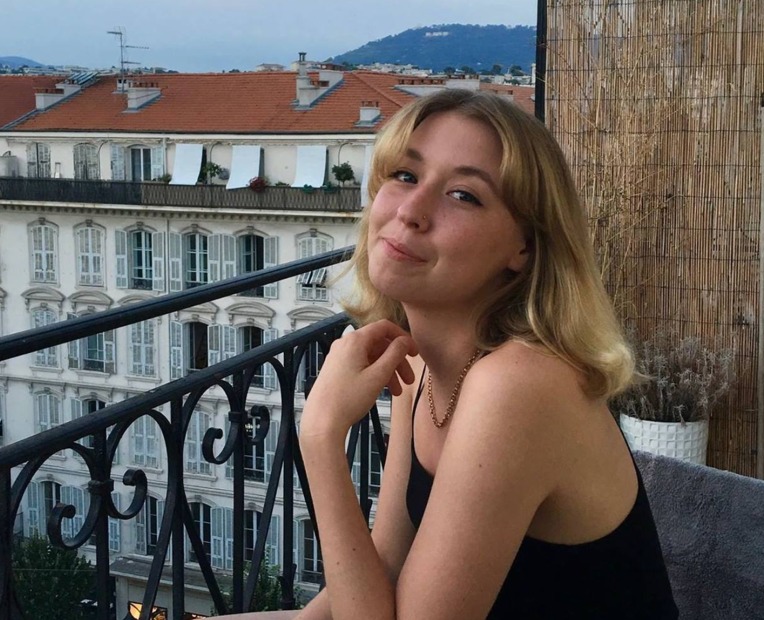
Student Biography:
Nike is a Northeastern University graduate currently living in Los Angeles and pursuing a career in the music industry. Although music is her deepest passion, she also enjoys writing and traveling. At Northeastern she studied music industry and business, with a focus on ethnomusicology.

